In my long-standing attempt to collect an example of every major longarm used by the US military, I just got this in a few weeks ago. It's a model 1816 Springfield .69 cal smoothbore flintlock manufactured in 1832. The M1816s were improved versions of the M1795, which was our very first domestic manufactured general military longarm and mostly used in the war of 1812. The M1795 was based on the French Charleville musket pattern used by the continental army in fairly large numbers---2nd only to the use of the Brown Bess overall. The US military determined that the Charleville pattern was superior to---and easier to, manufacture than the Bess so that's what they went with. The M1816 was produced from 1816 until 1844 and afterward, many were converted from flintlock to percussion so many soldiered on--even through the ACW.
This is one of the listing pictures that convinced me to purchase it. It actually looked even better in person than in these lightbox photos and came with a nice matching US marked and inspected bayonet. It's obviously been cleaned and the metal all buffed back to armory bright, so I got it at a good price. Click on any of the pictures to enlarge except the last photo of the reenactors
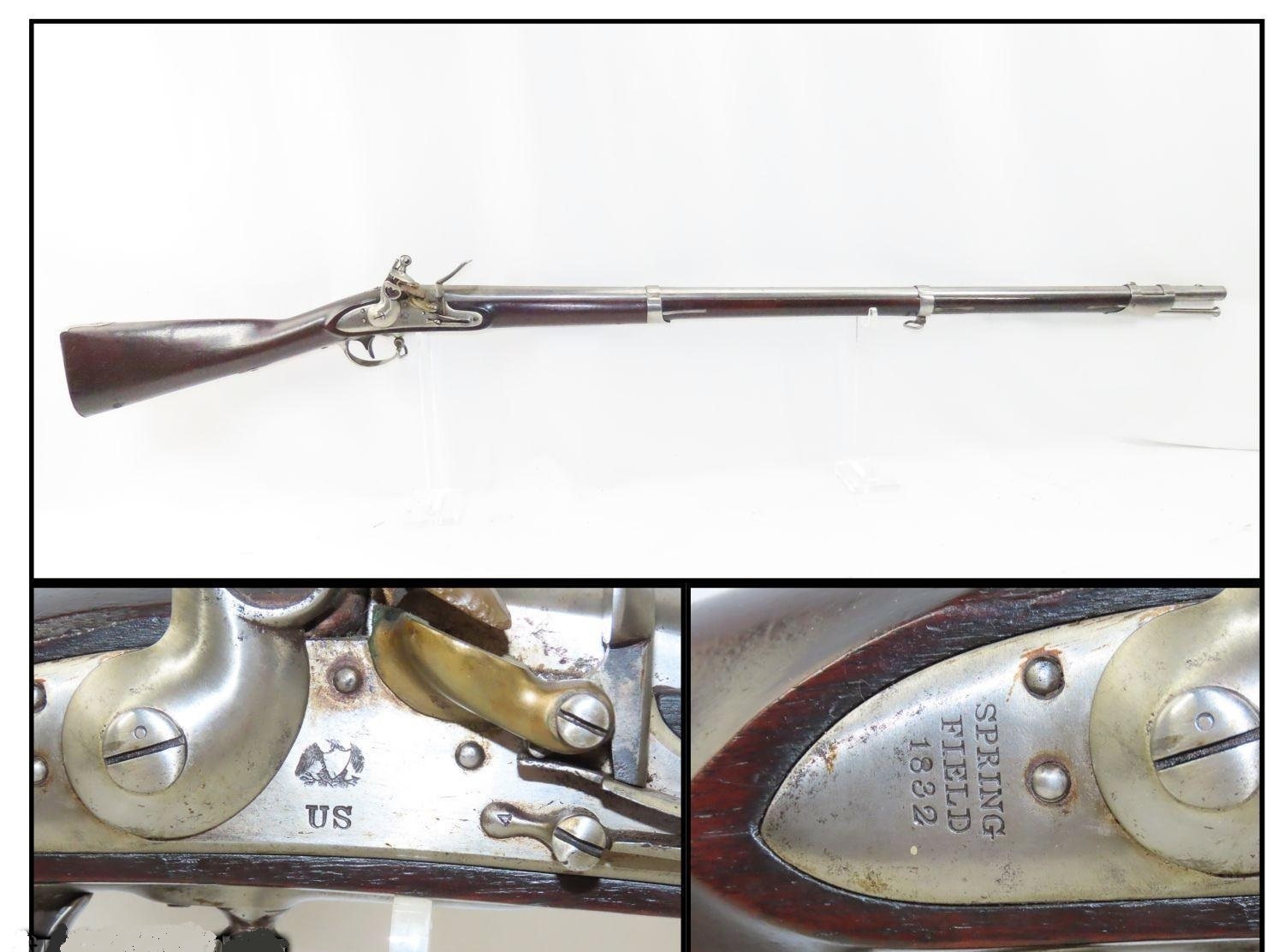
The M1816s were used in the 2nd Seminole war in 1835 and reportedly some older early models were used in the Texas War of Independence also in 1835. It then was our main battle musket for the Mexican-American war (1846-1848). Even though the army was in the midst of converting to percussion by the time of the Mexican-American war, the leaders and planners were worried about the logistics of keeping the armies on the Texas frontier and in Mexico supplied with musket caps. These caps could only be produced in sophisticated factory environments. Thus, if a soldier armed with a percussion firearm ran out of musket caps all he was left with was a fancy club or a spear if he had a bayonet. On the other hand, flints are long-lasting plus they are a naturally occurring mineral that can be found almost anywhere.
Here is it in person along with a few appropriate props. We were still using white buff leather during the Mexican-American war so that's what I went with for the photo. The Mexican war M1839 forage caps looked a bit like a modern police hat. click picture for full size
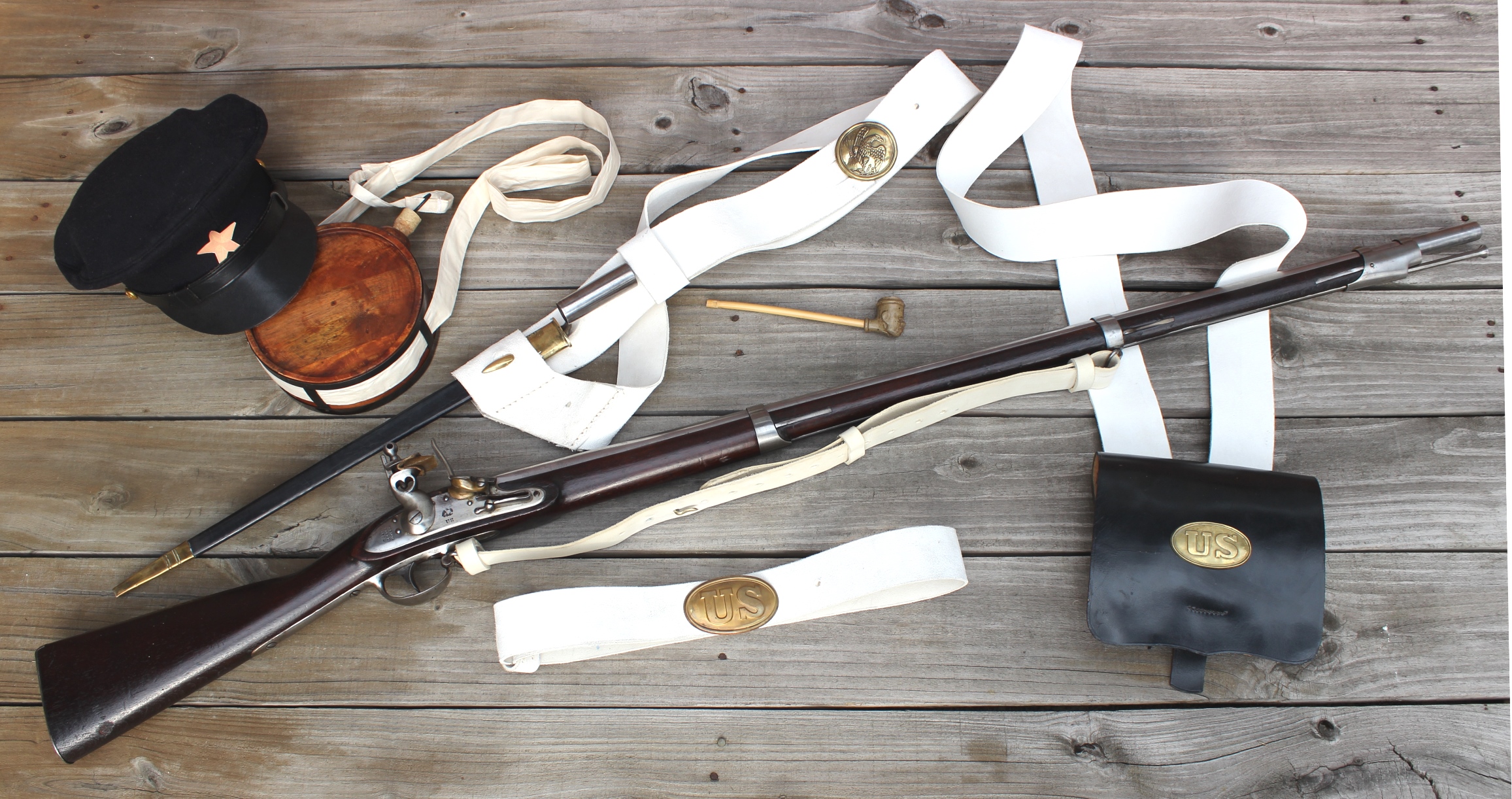
Between the Springfield and the Harpers Ferry armories plus a number of contract makers, over 700,000 of these were produced up until 1844. In the mid to late 1840s the armories started converting these to percussion while they also introduced the Model 1842 which was simply the M1816 design manufactured as a percussion model. These muskets remained our main battle musket up until 1855 when the .58 cal Minie ball was adopted. This meant that the army could finally convert to more accurate rifled muskets. Our military was also being issued rifles, such as the M1841 "Mississippi", during these earlier periods but they were reserved for specialty troops like scouts, skirmishers, and what were sometimes referred to as flanking units.
The Dragoons (cavalry) during the Mexican-American war were even issued early breech-loading rifles since managing a muzzleloader from horseback was problematic. Still, the smoothbore musket remained the main infantry longarm until 1855, because it was both easier to load, simpler to maintain, and required less training to use effectively.
It should be noted that due to the shortages of rifled muskets at the start of the ACW, 10s of thousands of the converted smoothbore M1816s saw service by both the North and the South in the early years of the war. Some Southerners were still carrying flintlock versions. Thus, this musket was in continuous service longer than just about any other US service arm--from 1816 to as late as 1864 or 48 years. Of course, these muskets were made more effective as smoothbores during the ACW by the use of "buck & ball" loads which were made up of 3 each quarter-inch buckshot on top of a .68 cal round ball.
My example still has faint images of the original military inspection cartouches in the wood.
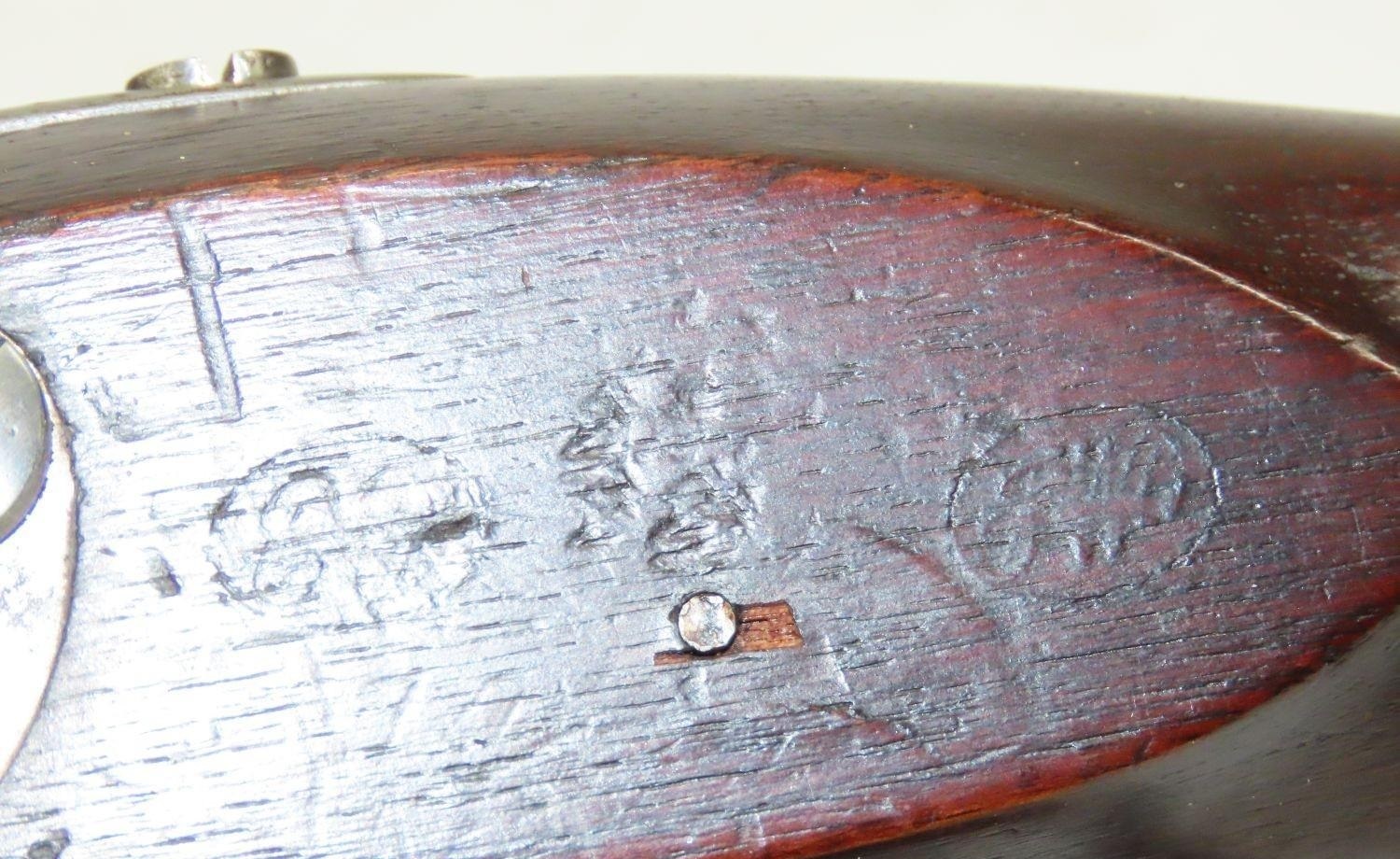
close up detail of the previous layout photo--click for full size
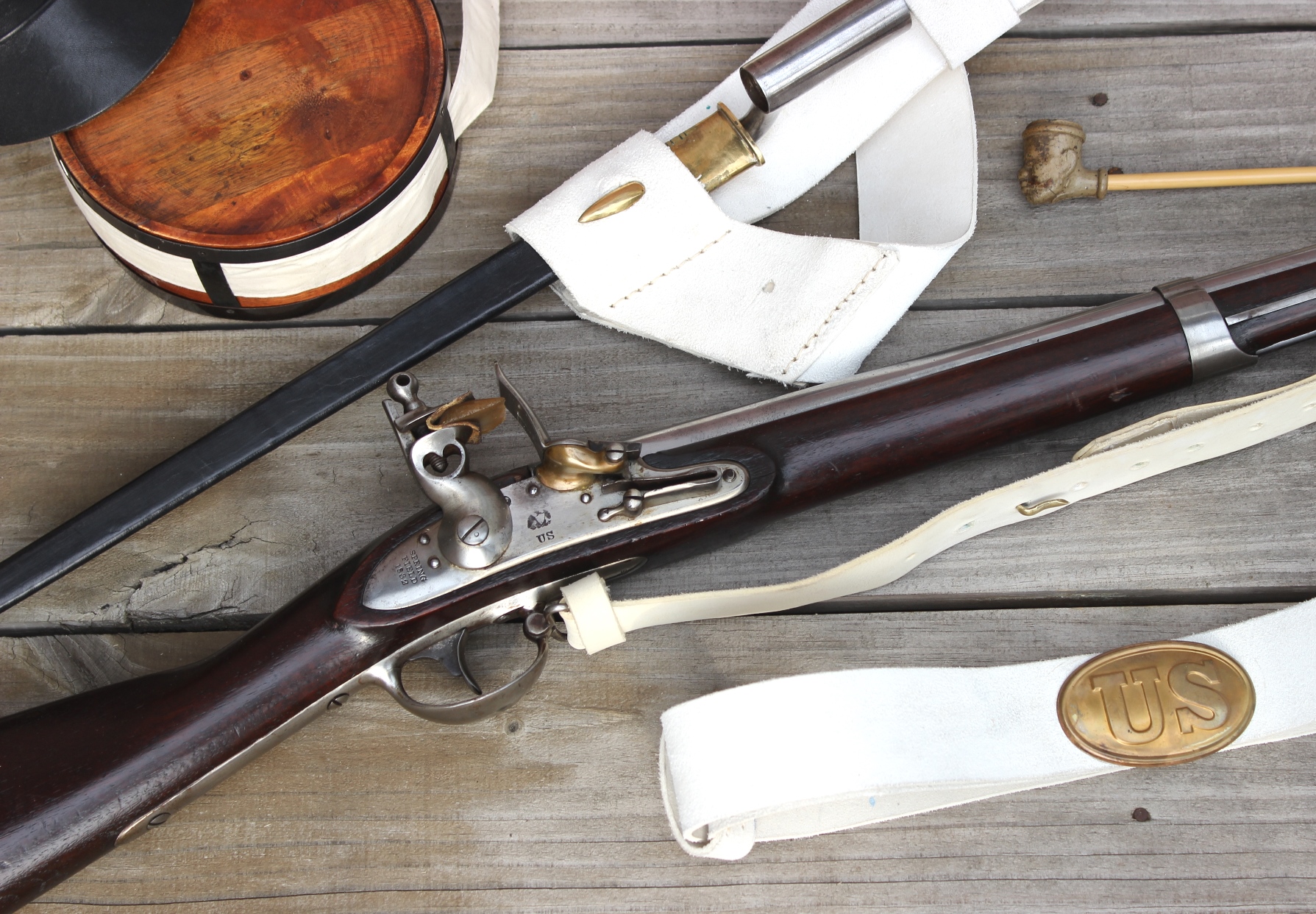
Finally, here's an old photo of some US regular reenactors from the Mexican-American war. Notice how their white buff slings make an X on the chest. I have been told that this was the inspiration for the white X symbols used to indicate infantry positions on a map. I will say that with all the gray in their beards, these guys look a little long in the tooth to have been a typical soldier of the period.
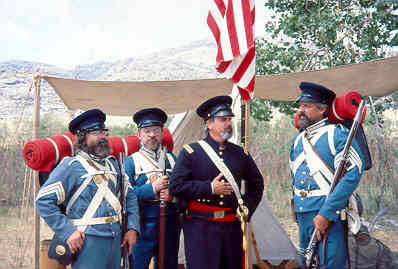
Thanks for reading and I hope I didn't bore you with information you already knew.
Cheers
This is one of the listing pictures that convinced me to purchase it. It actually looked even better in person than in these lightbox photos and came with a nice matching US marked and inspected bayonet. It's obviously been cleaned and the metal all buffed back to armory bright, so I got it at a good price. Click on any of the pictures to enlarge except the last photo of the reenactors

The M1816s were used in the 2nd Seminole war in 1835 and reportedly some older early models were used in the Texas War of Independence also in 1835. It then was our main battle musket for the Mexican-American war (1846-1848). Even though the army was in the midst of converting to percussion by the time of the Mexican-American war, the leaders and planners were worried about the logistics of keeping the armies on the Texas frontier and in Mexico supplied with musket caps. These caps could only be produced in sophisticated factory environments. Thus, if a soldier armed with a percussion firearm ran out of musket caps all he was left with was a fancy club or a spear if he had a bayonet. On the other hand, flints are long-lasting plus they are a naturally occurring mineral that can be found almost anywhere.
Here is it in person along with a few appropriate props. We were still using white buff leather during the Mexican-American war so that's what I went with for the photo. The Mexican war M1839 forage caps looked a bit like a modern police hat. click picture for full size

Between the Springfield and the Harpers Ferry armories plus a number of contract makers, over 700,000 of these were produced up until 1844. In the mid to late 1840s the armories started converting these to percussion while they also introduced the Model 1842 which was simply the M1816 design manufactured as a percussion model. These muskets remained our main battle musket up until 1855 when the .58 cal Minie ball was adopted. This meant that the army could finally convert to more accurate rifled muskets. Our military was also being issued rifles, such as the M1841 "Mississippi", during these earlier periods but they were reserved for specialty troops like scouts, skirmishers, and what were sometimes referred to as flanking units.
The Dragoons (cavalry) during the Mexican-American war were even issued early breech-loading rifles since managing a muzzleloader from horseback was problematic. Still, the smoothbore musket remained the main infantry longarm until 1855, because it was both easier to load, simpler to maintain, and required less training to use effectively.
It should be noted that due to the shortages of rifled muskets at the start of the ACW, 10s of thousands of the converted smoothbore M1816s saw service by both the North and the South in the early years of the war. Some Southerners were still carrying flintlock versions. Thus, this musket was in continuous service longer than just about any other US service arm--from 1816 to as late as 1864 or 48 years. Of course, these muskets were made more effective as smoothbores during the ACW by the use of "buck & ball" loads which were made up of 3 each quarter-inch buckshot on top of a .68 cal round ball.
My example still has faint images of the original military inspection cartouches in the wood.

close up detail of the previous layout photo--click for full size

Finally, here's an old photo of some US regular reenactors from the Mexican-American war. Notice how their white buff slings make an X on the chest. I have been told that this was the inspiration for the white X symbols used to indicate infantry positions on a map. I will say that with all the gray in their beards, these guys look a little long in the tooth to have been a typical soldier of the period.

Thanks for reading and I hope I didn't bore you with information you already knew.
Cheers
Last edited:













